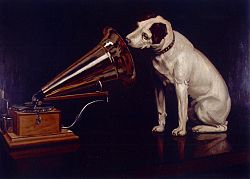The Library of Congress, in cooperation with Sony Music, has made available to the public a vast collection of historical recordings—the largest ever made publicly available online.
 On May 10, 2011 they officially launched the National Jukebox, a Web site that provides public access to over 10,000 recordings made between 1901 and 1925 by the Victor Talking Machine Company, still famous today for their advertisements featuring the dog Nipper listening to “His Master’s Voice” on a wind-up gramophone. These historical recordings are now owned by Sony, which has granted license for the Library of Congress to stream them online. Recordings available on the National Jukebox include not only music, but also spoken word recordings such as poetry and political speeches.
On May 10, 2011 they officially launched the National Jukebox, a Web site that provides public access to over 10,000 recordings made between 1901 and 1925 by the Victor Talking Machine Company, still famous today for their advertisements featuring the dog Nipper listening to “His Master’s Voice” on a wind-up gramophone. These historical recordings are now owned by Sony, which has granted license for the Library of Congress to stream them online. Recordings available on the National Jukebox include not only music, but also spoken word recordings such as poetry and political speeches.
Through the additional cooperation of the University of California, Santa Barbara, these recordings can be searched online via cataloging data provided by UCSB’s Discography of American Historical Recordings database, itself an expansion of their earlier Encyclopedic Discography of Victor Recordings database.
Also available on the National Jukebox site is an interactive digital facsimile of the 1919 edition of the Victrola Book of the Opera. This tome was developed as an advertising gimmick, but contains much valuable educational information. It includes descriptions and illustrations of over 100 operas, and the online version links to recordings of excerpts from each that were available from Victor Records. Some of these recordings were made by such early 20th century luminaries of the operatic stage as Enrico Caruso, John McCormack, and Geraldine Farrar, while others are popular overtures and instrumental arrangements.
Here are a few holiday-themed tricks and treats from this vast collection to keep you entertained during the Halloween season:
- Danse macabre — Arrangement of Saint-Saëns’ famous tone poem, played by Vessella’s Italian Band. An arrangement played by piano duo Guy Maier and Lee Pattison is also available, divided into Part One and Part Two because it is so long.
- “Erlkönig” — Franz Schubert’s terrifying setting of Goethe’s poem, performed by celebrated contralto Ernestine Schumann-Heink. An alternate performance by baritone Robert Leonhardt is also available.
- “Funeral March of a Marionette” — This short work by Charles Gounod famously accompanied Alfred Hitchcock’s unmistakable silhouette to open each episode of the television show Alfred Hitchcock Presents from 1955 to 1962.
- Gems from Jack O’Lantern — Medley of songs from a 1917 Broadway musical by Belgian composer Ivan “Fabulous Felix” Caryll.
- Gems from The Lady of the Slipper — Medley of songs from a 1912 Victor Herbert operetta that sets the Cinderella story during Halloween festivities. The recording opens with a number entitled “Games of Hallowe’en.”
- “The Ghost of the Violin” — Eerie song about a ghost (What ghost? What ghost?) who haunts an antique store and continues to perform on a violin at night. Written by composer Ted Snyder and lyricist Bert Kalmer and performed here by the ill-fated tenor Walter van Brunt with Maurice Burkhart.
- “The Ghost that Never Walked” — A song from Piff! Paff!! Pouf!!!: A Musical Cocktail, book by Stanislaus Stange, lyrics by William Jerome, music by Jean Schwartz. This comic song about “the Ghost of a troupe that disbanded in Peoria” was performed on Broadway by Eddie Foy, but is sung here by vaudeville singer and recording artist Billy Murray, known affectionately as “The Denver Nightingale.”
- “Skeleton Jangle” — Foxtrot by Nick LaRocca performed by the Original Dixieland Jazz Band, a group known for making the earliest recordings of jazz. The B-side of this recording is one of the most well-known jazz works of all time, the “Tiger Rag.”
- “The Skeleton Rag” — The American Quartet male vocal group performs this song by folksy Tin Pan Alley composer Percy Wenrich and lyricist Edward Madden.
Article by Bobby Griffith.
“His Master’s Voice” painting by Francis Barraud from Wikimedia Commons.


